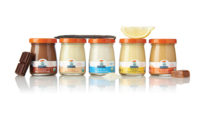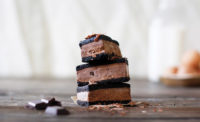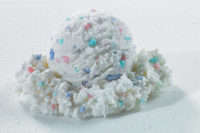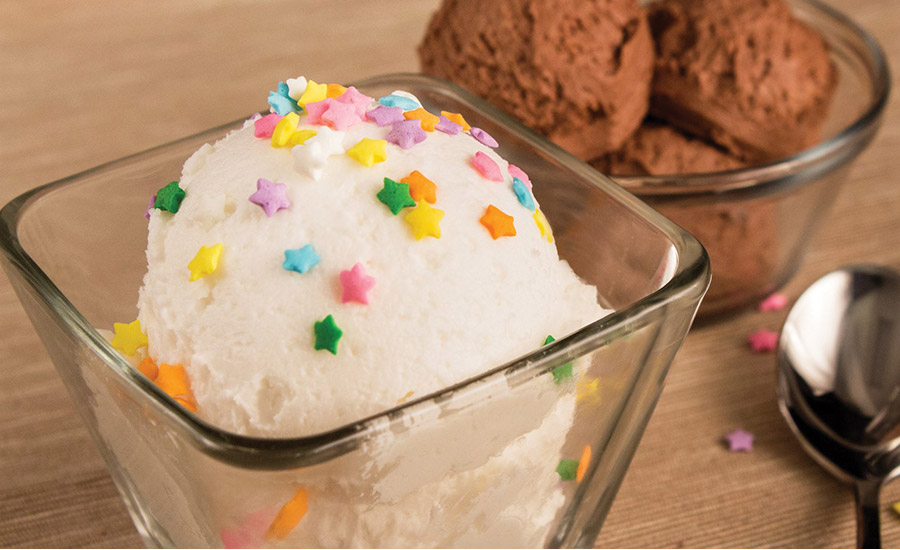Balancing health and indulgence in frozen desserts
Some consumers choose full-fat foods with a clean label over healthier lower-fat versions made with ‘chemical-sounding’ ingredients.

Photo courtesy of Matsutani

"Taste and nutritional benefits helps create an indulgent or premium impression in frozen dairy," says Hideki Fujihara of Matsutani Chemical Industry Co. Photo courtesy of Matsutani

Photo courtesy of TIC Gums



How does a dairy processor address the public’s enlightened attitude about nutrition while still appealing to its inclination toward indulgence?
In the case of frozen dairy, a successful formulation strategy isn’t as convoluted as some might fear. That’s because today’s dairy devotees are content to let wellness and indulgence coexist on two sides of the same coin; in some cases, they even conflate the two. And when that happens, consumers can have their ice cream cakes and eat them, too.
The Chicago-based market research firm Mintel found that 27% of Americans typically have more than one type or flavor of frozen treat in the freezer at any time. Nevertheless, Mintel noted, the broader frozen-treats market is “experiencing tepid growth.”
One key culprit is health. That 19% of consumers claim health as a factor in their frozen-dairy decisions doesn’t surprise Chelsea Rowel, the R&D supervisor at Parker Products, Fort Worth, Texas. She said she has observed “an increase in the amount of requests for ‘healthful’ frozen dairy desserts as consumers become more educated on wholesome foods and nutrition.”
“Healthful” in a dairy-dessert context is a relative term, said Kip Murphy, marketing manager at Virginia Dare, Brooklyn, N.Y. Among some consumers, “there’s a specific interest in reduced fat and reduced or no-added-sugar,” he said. For others, nutrients like protein, calcium, probiotics and fiber signal “good-for-you” and let consumers feel less guilty about their frozen snacks, Murphy said.
A healthy frozen dairy treat might as well be a clean one.
“Many consumers do equate clean ingredient decks with healthy,” said John Pimpo, a sales manager for Gertrude Hawk Chocolates, Dunmore, Pa. The absence of perceived negatives (such as GMOs and artificial preservatives) and the presence of kitchen-cabinet positives (recognizable ingredients) are key, he said.
The premium paradox
A consumer might perceive a full-fat, sugar-soaked, high-calorie frozen treat as more healthful than a reduced-fat, –sugar and –calorie alternative that happened to slim itself down by way of ingredient technology.
Consumers didn’t always think this way, as the fat phobia of the 1980s and ‘90s reminds us. Yet if premium ice cream — which owes its decadent status in no small part to its 12% to 14% milkfat content — now strikes consumers as “healthful” or “wholesome,” it merely reflects how far we’ve come since the days when fat was dietary enemy No. 1.
“Consumers will always permit some indulgence in their diets regardless of how strict their eating habits are,” said Catherine Barry, director of marketing for the National Honey Board. “But when they search for this indulgence, they want to find it in products with clean labels and all-natural ingredients that are familiar to them.”
In an era when “clean” connotes “healthy” as much as it does “premium” or “artisan,” treats that deliver all of the above give consumers the best of all possible worlds.
All-inclusive
How does a processor formulate frozen dairy desserts that deliver? By keeping things simple (but not simplistic). Consider the power of inclusions.
Mintel research from 2013 found that 24% of consumers consider the presence of “fun ingredients mixed in” an important factor when purchasing frozen treats.
“Inclusions can spin a concept in either direction: healthful or indulgent,” said Rowel.
Buttery caramels, nutty pralines and sweet toffees with chocolate are in the indulgent category. But a processor can put a healthful or wholesome spin on the those same inclusions by using organic sea-salt caramel, honey-glazed pumpkin seeds or cocoa-dusted toffee clusters made with brown rice crisps or ancient grains, Rowel said.
Less is more
Equally important is the serving size and how much one chooses to consume, Pimpo said.
Perhaps that explains why frozen-dairy formulators are increasingly leveraging portions as a vehicle for balancing virtue and indulgence.
The concept is not lost on Melanie Swannell, a chemistry and food science student at the University of Wisconsin, Madison, and member of its Frozen Dessert Center team.
“Because you purchase ice cream in a specified volume, you can manipulate that volume to fit different criteria,” she said.
Some bars are formulated for 100-calorie servings while a pint-sized package is often “perceived as the indulgent single serving,” she said.
Alan Owen also has noticed a downsizing of novelties like cones, sandwiches and pops, as well as “an avalanche” of pint introductions of full-fat ice creams, sorbets and gelatos. Owen is the sweet flavors marketing director for Sensient Flavors, Hoffman Estates, Ill.
“Many of these products are super-premium and priced accordingly” which suggests that “consumers aren’t abandoning the category, but are just consuming less per occasion,” he said.
Room to explore
Gelato has grown in popularity because “people think of it as being healthier than ice cream, but still an indulgent treat,” said Richard W. Hartel, a professor of food engineering at the University of Wisconsin and an advisor to its Frozen Dessert Center.
At 3% to 8% fat, gelato is leaner than premium ice cream, but its lush, dense texture — a consequence of lower overrun — and reliance on fewer but fresher and more “upscale” ingredients get it picked up by the radar of contemporary frozen dairy consumers.
In its “Ice Cream and Frozen Novelties” report, Mintel called gelato “a bright spot for the U.S. market,” with 43% of consumers purchasing it in the six months leading to April 2016 (compared to 39% during the same period in 2015).
“Building a brand or product story around region-specific sourcing as well as the use of varietals creates an artisan, premium perception that’s been particularly effective in the success of gelato,” Owen said.
And it can succeed with other frozen dairy desserts. Instead of sourcing run-of-the-mill vanilla, look for Madagascar or Bourbon varieties. Don’t just highlight an ice cream’s blackberry profile, but seek out Marion blackberries that will make the dessert extra special.
Varietal forms of honey can add to a dairy dessert’s backstory and give it a distinctive sweetness.
Honey “has a positive perception among consumers and since it’s made in nature, it satisfies clean-label demands,” Barry said.
“With frozen dairy products, ingredient quality is key, as is the use of inclusions, swirls and other additions that elevate a product beyond a standard offering,” Barry said.
It’s up to each consumer to define what “premium-healthy” means to them, she said. “But then it’s up to food manufacturers to determine how they want to position their products.”
Looking for a reprint of this article?
From high-res PDFs to custom plaques, order your copy today!








